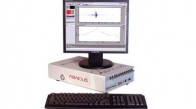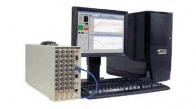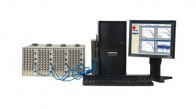 The industry standard just got better. SignalStar shaker controllers combine the power of a distributed DSP architecture and the acclaimed Data Physics control algorithms delivering uncompromised control performance with greater than 120 dB of dynamic range, control frequency ranges of up to 20 kHz and up to 1000 channels.
The industry standard just got better. SignalStar shaker controllers combine the power of a distributed DSP architecture and the acclaimed Data Physics control algorithms delivering uncompromised control performance with greater than 120 dB of dynamic range, control frequency ranges of up to 20 kHz and up to 1000 channels.
Scalar offers single shaker vibration control with up to 8 input channels, Vector provides advanced single shaker control capabilities for up to 32 input channels, and Matrix supports both high channel count (up to 1000 channels) single shaker control and multi shaker control. No matter what your testing needs, there is a matching controller in the SignalStar family.
SignalStar SCALAR Controllers
 Optimized for Low Cost and Simplicity
Optimized for Low Cost and Simplicity
SignalStar Scalar does not require a host computer. It is made easy to use by leaving out parameters that are rarely required. It gives you the best of both worlds. No other vibration controller compares with the combination of simplicity and powerful control in a package that costs so little.
SignalStar Scalar is the ideal vibration controller for users looking for a powerful system yet are on a tight budget. SignalStar Scalar derives its capability from the acknowledged leader of vibration control, SignalStar Vector, incorporating the same powerful ABACUS digital signal processing hardware and control algorithms. Scalar is offered in a basic configuration with only the most commonly needed features. Unlike most entry level controllers, Scalar can be configured with optional features that are usually offered only on the most advanced vibration controllers, making it easy to configure just the right system for your test and your budget. The ability to add software options in the future also protects your investment in Scalar as your testing needs grow.
Random, Sine, Classical Shock and more…
SignalStar Scalar offers a comprehensive suite of closed loop vibration control software including, Random, Sine, Classical Shock and Transient, SRS Synthesis, Mixed Mode and Time Waveform Replication. Each is offered with a basic feature set and optional features, allowing you to customize the system to meet your needs. Random tests can be performed up to 5000 Hz (expandable to 20,000 Hz) with a reference spectrum of up to 800 frequency lines (expandable to 6400 frequency lines). Swept sine tests can be run from 2 to 5,000 Hz (expandable to 20 kHz) and Shock tests can be run with sample rates up to 107.5 kHz and frame sizes up
to 8192 points (expandable to 65,536 points).
Powerful DSP based system
Scalar is a compact PC-based vibration controller incorporating 32-bit floating point digital signal processors for closed loop control signal processing. Scalar may be configured with 4 to 8 input channels for control and analysis. Each input channel has a maximum sampling rate of 107 kHz enabling accurate time domain reproduction of high frequency signals which is critical for transient shock and time replication. High quality analog components with 24-bit analog to digital converters provide up to 150 dB of dynamic range. Scalar input channels are software selectable as single ended or differential to eliminate common mode noise associated with ground loop problems. Software selectable ICP power for transducers is standard.Scalar does not sacrifice control performance for system simplicity. Scalar incorporates a powerful DSP based control engine for realtime control. Over 1 GFLOP of processing speed ensures fast, stable control. Graphical user interface, networking and data storage are managed by an embedded PC running Microsoft Windows XP operating system.
Intuitive Operation
SignalStar Scalar is designed with ease of use in mind. Each control application follows the same simple steps for test setup. Test parameters are organized in a single dialog that leads the user through setup of control parameters, reference profile, and input channels. The run schedule lists all automatic operations during the test such as level changes, dwell operations, data saves, and printing commands. New tests are created from the standard default template or from an existing test by copying and editing.SignalStar Scalar offers three standard graphic layouts for display of test data in the three phases of a vibration test: pretest, run and review. These layouts may be customized by the user to have up to 16 graphs and up to 8 signals per graph. All relevant signals are available for display such as Control, Measurement Channels, Drive, Error, Transfer Functions, Reference, and Tolerance Limits. For more flexibility the advanced layout manager option provides the ability to define an unlimited number of graph layouts each with up to 32 graphs and up to 16 signals per graph.
Tests can be run in a fully automatic mode or the user can manually modify test functions from the test control panel. The optional security feature allows passwords and permissions to be set for each user. Permissions can be set based on the experience level of the user. This enables Scalar to have the power and flexibility to run difficult tests, while retaining the ease of operation and safety required for novice users.
Sophisticated Safety Features
Scalar provides extensive safety features to protect test equipment and the device under test. Its advanced realtime control algorithms and high signal to noise ratio guarantees that the controller will maintain proper testing levels by adapting quickly to dynamic structures. Expected peak displacement, velocity, and acceleration are compared to shaker limits prior to running the test. During Pretest, the system determines if the loop is open or closed for all control channels and reports if poor test conditions exist. The control signal is continuously compared against alarm and abort limits and, if the control signal drops out due to a dislodged accelerometer or broken cable, the system instantly aborts. The large external abort switch is connected directly to the control engine to ensure rapid safe shutdown under any circumstances.
Comprehensive Test Documentation
Each time a test is run, Scalar automatically documents every event that occurs to ensure that all information pertinent to the current run is saved. At the beginning of the test, if Run Notes are enabled, up to eight user defined prompts can be displayed requiring the operator to enter key test identification information such as name, date, or test item serial number. During the test, information such as date and time of start, operator interactions, and reason for test ending are automatically recorded in the Run Log. When a test ends, Scalar stores all signals to record ending conditions. In addition, all scheduled and operator selected data Saves are linked to the Run and its documentation. With complete documentation, you can be certain all relevant information is always available for review and reports. Customized reports can be created with your own templates for headers and footers, and can include graphics, such as your company logo.
DATAPHYSICS SCALAR Controllers Brochure
SignalStar VECTOR Controllers
The Industry Standard
SignalStar Vector is a Vibration Controller that runs on ABACUS, the world’s first DSPcentric engine. Vector provides a comprehensive system satisfying all modes of vibration testing: Random, Sine, Resonance Search and Dwell, Classical Shock, SRS, Transient, Sine on Random, Random on Random, and FFT Analysis.
engine. Vector provides a comprehensive system satisfying all modes of vibration testing: Random, Sine, Resonance Search and Dwell, Classical Shock, SRS, Transient, Sine on Random, Random on Random, and FFT Analysis.
Powerful DSPcentric Architecture
Closed loop vibration control requires a large amount of real-time computation. SignalStar Vector Vibration Controller distributes this burden over multiple Digital Signal Processors. Vector can be configured with 8 to 32 channels, any or all of which can be combined into one control signal as an averaged or external spectrum. Remaining inputs may be used as limit channels to protect the test item. Differential inputs on all channels eliminate potential ground loop problems and provide a high level of protection against noisy environments. ICP power for all channels is standard. With a 24 bit ADC per channel, you get increased signal-to-noise ratio for accurate measurements required to control “high-Q” resonances or deeply notched references. Dual cascaded DACs with reconstruction filters generate pure analog signals for all applications, including true analog sine-sweep to excite all frequencies in a specified band.
SignalStar Vector Vibration Controller interfaces to any PC, desktop or laptop, running Windows via a high speed Ethernetconnection.
Distributed Digital Signal Processing Architecture
ABACUS is a compact, modular system, configurable with 4 to 32 input channels. The distributed digital signal processing hardware architecture is ideal for vibration control applications where signal processing speed is critical for realtime control. Each input module, providing up to 8 channels, has a 32-bit floating point DSP rated at 1 GFLOP. As the number of input channels in a system increases, so do the number of digital signal processors. The result is control loop processing that is not dependent on the number of input channels. ABACUS provides sample rates of up to 107 kHz for accurate reproduction of high frequency vibration. A local throughput disk in the ABACUS allows simultaneous recording to disk of time data at up to the maximum sample rate on all input channels with no loss of data.
Since measurement and output signal accuracy is essential to vibration control, high quality analog compo-nents with 24-bit analog to digital and digital to analog converters are used to provide up to 150 dB of dynamic range.
Software selectable single ended and differential inputs eliminate common mode noise associated with ground loop problems. TEDS support and ICP power are provided under software control.
Advanced Control Capabilities
Vector benefits from Data Physics more than 25 years of experience in developing proprietary algorithms for closed loop vibration control. Vector vibration control software encompasses the complete range of vibration environments. Random vibration can be controlled up to 20 kHz bandwidth, with up to 6400 frequency lines. Multi reference limit profiles provide the ability to limit the drive signal at frequencies where vibration levels can cause damage to the test article. Sine employs high quality digital tracking filters to accurately measure amplitude of true continuous swept sine signals. The resonance search and dwell option automates the identification of resonances and enables phase tracked dwell for fatigue testing. Transient frame sizes of up to 65,535 points and sample rates up to 107 kHz allow both long duration seismic and high frequency pyrotechnic shock control.
Powerful Analysis Capabilities
SignalStar Vector provides up to 32 input channels for analysis of the dynamic response of devices under test. The powerful graphical user interface makes extensive online analysis possible. Vector displays can be configured with up to 32 graph windows containing up to 16 signals each. All relevant signals are available for live display such as Control, Response Channels, Drive, Error, Transfer Functions, Reference, and Tolerance Limits. Live test data is available in both time and frequency domain. Single, dual, harmonic and peak pick cursors are available on every graph. Cursors can be locked for synchronized movement among windows, or they can be controlled independently. Annotation can be added to graphs in the form of user text or param-eters automatically extracted from the test setup or data file.
Independent Measurements
Vector has the ability to make independent measurements of transfer functions, auto spectra, and cross spectra during random vibration control tests. These measurements may be independently scheduled to occur at any time during the random test and may be tailored to the analysis task. Measurement data may be used for further analysis, such as operating deflection shape and operating modal analysis.
Throughput to Disk
Disk throughput allows continuous (gap free) simultaneous time streaming to the local disk in the ABACUS hardware during vibration control testing for all channels at up to 107 kHz. Throughput can be manually started and stopped multiple times during a single test. Throughput data can be post processed using either SignalCalc Analyzer or SignalCalc DSA software. Analysis Options include auto and cross spectrum analysis, Sine Data Reduction, and SRS Analysis.
DATAPHYSICS VECTOR Controllers Brochure
SignalStar MATRIX Controllers
Acclaimed Data Physics Algorithms
 SignalStar Matrix Vibration Controller unites the all new ABACUS DSPcentric hardware platform with the highly acclaimed Data Physics vibration control software to produce a complete and fully integrated solution redefining the boundaries of vibration testing. The greatly intuitive User Inter-face makes it easy to setup and run the most sophisticated vibration tests to the top specifications in the Industry.
SignalStar Matrix Vibration Controller unites the all new ABACUS DSPcentric hardware platform with the highly acclaimed Data Physics vibration control software to produce a complete and fully integrated solution redefining the boundaries of vibration testing. The greatly intuitive User Inter-face makes it easy to setup and run the most sophisticated vibration tests to the top specifications in the Industry.
Unique
Matrix provides time and frequency domain displays of drive, control and measurement signals to give the operator immediate feedback on control quality. For example, harmonic distortion in Sine or sigma clipping in Random can be measured and displayed. A unique feasibility check is provided by the pre-test mode which does a loop check, assesses the integrity of all system inputs, measures the system transfer function matrix and verifies that the test may be run safely on the selected shaker system. The User Interface language can be chosen from a list allowing an operator in France, Germany or Japan to operate the system as easily as an operator whose native language is English. A well-presented test report says a great deal about the quality of the test. SignalStar Matrix desktop publishing module allows users to design professional quality reports, which can be automatically created during operation. All equipment in your lab only need to be logged once in the system which can then be quickly recalled when creating tests.
Modular, Expandable, Digital Signal Processing System
SignalStar Matrix is the preferred vibration controller for high end applications. Matrix provides coupled and uncoupled multi shaker control for up to 16 shakers. In single shaker applications, Matrix supports up to 1024 input channels which can all be used in any combination of control and limit channels.
ABACUS networked, distributed DSP architecture provides unlimited expansion possibilities. Multiple 32 channel ABACUS chassis are connected to the host PC through a Gigabit network switch. Synchronization cables between ABACUS chassis ensures excellent phase match between channels in the system.High quality analog design with 24-bit analog to digital and digital to analog converters provide up to 150 dB dynamic range. ABACUS also provides software selectable single ended and differential inputs to eliminate common mode noise associated with ground loop problems. ICP power for transducers can be selected in the software and also supports TEDS Smart transducers.
The ABACUS distributed digital signal processor hardware architecture is ideal for vibration control applications, where DSP speed is essential for realtime control. A 32-bit floating point digital signal processor on each module supports up to 8 input channels and 2 output channels and ensures sufficient control processing power with additional input channels. A local throughput disk in each 32 channel ABACUS chassis means that time data can be streamed to disk during control at 107 kHz on all channels, regardless of the number of channels or the number of ABACUS chassis.
High Channel Count Single Shaker Vibration Control
SignalStar Matrix benefits from more than 25 years of experience that Data Physics has in developing proprietary algorithms for closed loop vibration control. Matrix vibration control software encompasses the complete range of single shaker vibration environments. Matrix provides single shaker applications features designed for high channel count vibration control. Continuous throughput to disk during control and force limiting make Matrix ideal for satellite qualification testing. Up to 1024 input channels may be used for control and limiting. Each limit channel can have a unique limit profile for alarm, abort and drive limiting.Control tasks are distributed to the digital signal processors on each ABACUS chassis to ensure optimum control performance, regardless of channel count. Local throughput disks in each ABACUS enable continuous recording to disk for any number of channels or ABACUS chassis.
Multi Shaker Vibration Control
The real vibration environment for a structure is complex with multiple excitation sources. Using SignalStar Matrix, it is now possible to perform more precise and realistic testing than ever before, using multiple shakers to simulate the complex environment.Matrix addresses the complete range of multi shaker test requirements, from IEEE 344 multi axis seismic testing to 6 DOF time data replication testing. Matrix uses continuous control to adapt to the dynamics of the system under test. Compensating the cross coupled dynamic responses of the multiple inputs simultaneously yields high control accuracy. Matrix offers independent reference definition of each control point with defined phase and coherence between control points.
Multi Shaker Single Axis
Large products, particularly those that are physically long such as space vehicles, may require more complex testing where more than one shaker is used to provide controlled vibration at different points of the struc-ture. This can involve the control of the individual vibration profiles and of the phase relationships between them.
Multi Shaker Multi Axis (Table)
Components and substructures can be tested on specially designed shaker tables with motion in many degrees of freedom. Seismic qualification tests are performed by mounting a test item to a large multi axis shaker table. Automotive subassemblies are often tested on smaller multi axis tables.
Multi Shaker Multi Axis (Direct)
Entire automobiles, aircraft, turbomachinery and other large structures are subjected to the simultaneous excitation of multiple shakers, each directly attached to a point of environmental load input. This provides a realistic simulation of the operational loading under laboratory control. Motion Replication, such as road simulation, is often performed in this configuration.


